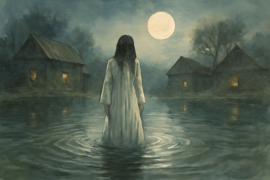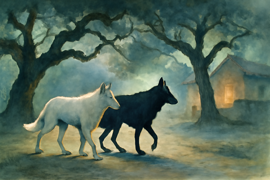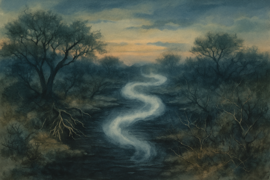Introduction
Stretching across the southern reaches of Texas, where the waters of the Rio Grande entwine with winding resacas and the scent of mesquite drifts on warm desert breezes, the Rio Grande Valley harbors stories older than any highway sign or county border. Beneath a canvas of fiery sunsets and starlit sky, every river bend and thicket of huisache has its own woven tapestry of whispers and warnings. Even modern towns like Brownsville, Harlingen, and McAllen guard pockets of wild land where elders still recall the crackle of campfires and the hush of tales born in whispered tongues. From the faint call of a midnight heron to the flicker of lanterns in forgotten cemeteries, this land echoes with the footsteps of ancestors and spirits that dance just at the edge of sight. Here, the living and the dead share the same dusty trails, and the murmur of ancient voices can slip through open windows on nights when the wind carries secrets from both sides of the river. In these pages, you will meet La Llorita, whose lament echoes through the reeds; the twin hounds of El Cadejo, whose eyes blaze with both protection and peril; and the guardians of the resacas, spirits that rise in gentle shapes to shield the flow of life. Each tale unfolds in the hush between heartbeats, begging you to listen closely to the rhythm of the valley itself. As you turn each page, lean forward—you may just catch sight of something stirring at the water’s edge.
Whispers of the Weeping River
For as long as memory stretches in the southern Rio Grande Valley, the gentle bends of the resacas have cradled both life and sorrow. They bear the weight of every whispered secret and stolen promise, winding through fields of sugar cane, past abandoned ranch houses, and into the heart of the dark woods where even twilight seems to hesitate. In the hush before dawn, old timers swear they hear a voice floating above the water—soft, tremulous, and aching with longing. They call her La Llorita, the little weeper of the river. Some say she was a young mother centuries ago, driven by grief when her infant vanished beneath a current too swift to tame. Others speak of jealousy and betrayal, a love betrayed beneath a serenade of stars. Whatever her origin, the result is the same: a spirit bound to the flowing channels, her tears forever mingling with the ebb and flow.

They say La Llorita drifts between cattails and tangled roots, wearing a gown of tattered lace that ripples like water. On the darkest nights—when the moon hides behind clouds and the only sound is the croak of frogs—she rises, her face veiled by strands of hair. Fishermen pull their boats ashore; travelers veer away from the banks. If you catch her sight, the air will tremble with the echo of her cry, a lament so raw it twists the soul. But the few who offered solace—leaving flowers at the water’s edge or softly calling her name—claim she paused, her tears slowing, before dissolving back into mist.
Families who live near the resacas pass down warnings: never cross the water without speaking a prayer, never leave a child’s toy by the bank, and always respect the hush of the river after dark. In low voices, they recount nights when lantern light revealed a tiny handprint on the side of a canoe, fading as quickly as it came. Grandmothers rock at dusk, murmuring old lullabies meant not for infants but for wandering souls. And sometimes, just sometimes, a mother hears a gentle coo on the breeze and feels a soft kiss land on her cheek, reminding her that love can linger beyond the last breath.
Even modern floodlights and resort developments cannot silence the resacas’ tender sorrow. Beneath concrete bridges and through irrigation channels, the river’s heartbeat continues—steady, relentless, guided by the invisible presence of the little weeper. She is a reminder that in this sun-drenched land, every life flows into something larger, and every loss finds its voice in the sigh of water against shore.
Shadows of the Twin Hounds
On dusty back roads that thread between citrus groves and dilapidated homesteads, the night air sometimes carries the sound of paws on hard earth. Locals speak of El Cadejo, two spectral canines who prowl the boundary between protection and peril. One hound is snowy-white, its coat glowing with otherworldly light; the other is coal-black, its eyes smoldering like embers in the darkness. Neither bark nor whine escapes them—they move as shadows, silent sentinels on four legs.

Legend holds that the white Cadejo appears to travelers burdened by heavy hearts, guiding lost souls back to safety. Wandering vaqueros, wary border crossers, and even lonely children have reported a gentle nudge at their heels, a soft breath like wind on their necks, and a path illuminated by moonlight stepping stones. Yet where one guide walks, the other watches. For the black Cadejo seeks those who surrender to vice and temptation: the drunkard stumbling into ditch, the thief skulking behind closed doors, the soul who values everything but truth. To those it finds wanting, it offers no mercy. Tales of terrifying growls, eyes flaring with malevolence, and silhouettes lunging from the brush are whispered around campfires at night.
In small border villages, families maintain altars of jade and blue glass beads in honor of the white Cadejo, leaving bowls of fresh water and sweet tamarindo candy. They believe these offerings keep the benevolent spirit close, warding off the darkness that roams just beyond streetlamps. When the harvest moon hangs low, children fold origami dogs and hang them by cotton threads in trees; they hope the playful shapes will draw the protective hound near. Conversely, travelers heed the warning to avoid loose talk and sinful deeds, for the black hound’s silence is the prelude to dread.
Anthropologists have traced the Cadejo’s roots to Central American folklore, but here in the valley it has become something of its own: a living emblem of duality, a reminder that every choice echoes in midnight’s hush. Those who embrace kindness find a patient guide beside them; those who court darkness might glimpse a pair of burning eyes before the world goes cold.
Guardians of the Resaca
In the tangled marshlands where cattails sway and dragonflies hover like jeweled sparks, another legend unfolds beneath the sway of tall grass and creeping vines. Locals call them the Guardian Spirits of the Resaca—creatures neither fully animal nor wholly human, charged with watching over the lifeblood of the valley. Some describe shimmering figures that emerge at dawn’s first light—forms reminiscent of manatees or river otters, glowing with soft luminescence, drifting through channels too narrow for any mundane creature. Others speak of ancient palms that weep emerald tears when the water level dips too low, or of roots twisting skyward, resembling grasping hands.

The most common tale tells of two luminous manatee-like beings, sisters bound to the resaca since time immemorial. On still mornings, residents swear they hear the gentle thrum of breathing beneath lily pads, or catch sight of bulging eyes at the surface, beckoning them to care for the water. Farmers who neglect irrigation lines find their crops wilting within days; those who honor the spirits with fresh fruit offerings and respectful whispers report healthy fields and milky river fish that taste sweeter than any market catch.
During a harsh drought in the 1930s, stories tell of a young girl named Rosita who waded into a shallow channel to confront the drying earth. As she knelt at the water’s edge, two glowing figures rose around her—bodies shifting between fin and limb, mothers whispering in a song older than Spanish. They guided Rosita to a hidden spring, its water cold and clear, which flowed back into the resaca and saved the entire community. To this day, families mark that spot with painted stones and crimson ribbons tied to mesquite trees.
Yet these guardians are not to be trifled with. Hunters who venture too deep into the marsh with blood on their hands have reported whips of water slapping against their legs, low growls echoing through the reeds, and the sudden disappearance of their prey. They return to camp shaken, vowing never to harm the resacas again. In that solemn hush, one truth remains clear: life in the Rio Grande Valley springs from these winding waters, and the guardians will defend it with every ripple and echo of mist.
Conclusion
As dawn spills gold across the southern fields and the resacas gleam like veins of light, the spirits of the Rio Grande Valley recede into the hush once more, awaiting the next listener brave enough to heed their call. These legends—woven from grief and hope, shadow and protection—remind us that the world beyond human sight teems with wonders and warnings alike. When you walk the levees at twilight, keep your voice kind and your steps gentle. Leave an offering of fresh water for La Llorita, and she may spare you her lament. Whisper a prayer for the white Cadejo, so it will guide you safely home. Honor the guardians of the resacas, and your fields may flourish under the Texan sun. In these winding waterways, every ripple carries a story, and every whisper is a bridge between the living and those who dwell in moonlight. Carry these tales in your heart, for in this land of shift and shadow, respect for the unseen is the first step toward harmony with all that flows and breathes alongside us, now and for generations still to come.
May the spirits watch over you, and may you forever walk under a kind moon in the southern Rio Grande Valley without fear of what stirs just beyond the glow of your lamp.
Farewell, traveler—until your next journey down these haunted waters, the LRGV Legends will be waiting to greet you with open enigmas and the persistence of wonder. Each echo, each rustle in the brush, each flicker of mist holds a fragment of the valley’s soul, a reminder that stories never die—they flow on like the river itself, finding new hearts to touch under every star-lit sky.

















